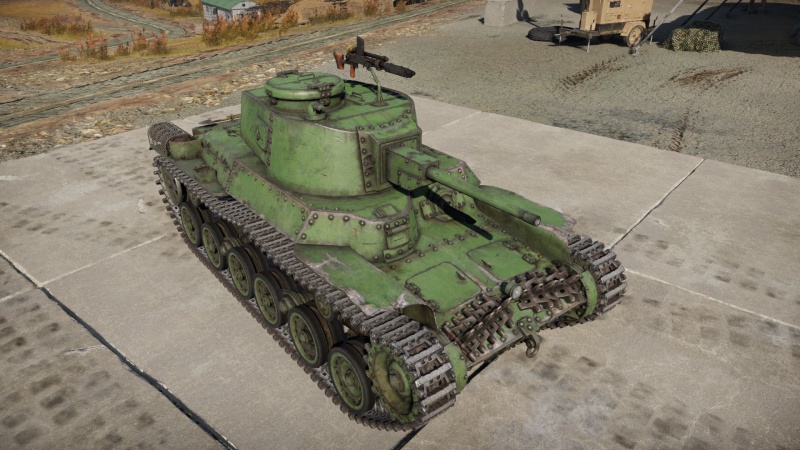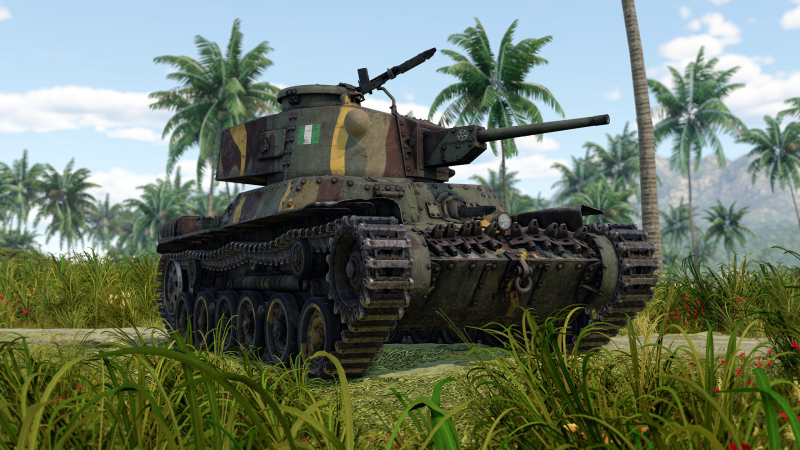Chi-Ha Kai
| This page is about the Japanese medium tank Chi-Ha Kai. For other variants, see Chi-Ha (Family). |
Contents
Description
The Type 97 Chi-Ha Kai (九七式中戦車 改「チハ」) is a rank Japanese medium tank with a battle rating of (AB), (RB), and (SB). It was introduced along with the initial Japanese Ground Forces tree in Update 1.65 "Way of the Samurai".
General info
Survivability and armour
The Chi-Ha Kai has little to no armour against its common opponents like the Pz.II. The hull is identical to its predecessor, the Chi-Ha; while the turret is new, it has no better protection as well. With only 25 mm of armour on the turret cheeks and the frontal plate, and 20-25 mm at the hull sides, its protection is comparable with light tanks at its battle rating. The thin armour might, with some luck, protect against some auto-cannon shells while angling, or low penetration shells from range, while the highly sloped front glacis plate can also ricochet poorly aimed smaller calibre rounds. However, in general the armour should not be relied upon.
Unfortunately, when being hit and penetrated, the Chi-Ha Kai is usually destroyed with one or two shots. However, this tank has a fairly small frontal profile, making it harder to be hit. Also, for the guns lacking post-penetration damage, the Chi-Ha Kai has an alright survivability, as it has a total of 5 crews and they are fairly spaced out due to the long hull. The huge transmission system at the front of the tank can also serve as further protection for the crew members, absorbing penetrating hits at the price of disabling the transmission, making the tank immobile and thus vulnerable.
Armour type:
- Rolled homogeneous armour
| Armour | Front | Sides | Rear | Roof |
|---|---|---|---|---|
| Hull | 25 mm (11-31°) Front plate
15-17 mm (62-80°) Front glacis 15 mm (37-59°) Lower glacis |
25 mm (25 / 40°) Top
25 mm Bottom |
15 mm (69°) Top
20 mm (5-57°) |
12 mm |
| Turret | 25 mm (9-10°) Turret front
30-35 mm Gun mantlet |
25 mm (9-10°) | 25 mm | 10 mm |
| Armour | Sides | Roof | ||
| Cupola | 25 mm | 10 mm |
- Suspension wheels and tracks are 15 mm thick.
Mobility
| Game Mode | Max Speed (km/h) | Weight (tons) | Engine power (horsepower) | Power-to-weight ratio (hp/ton) | |||
|---|---|---|---|---|---|---|---|
| Forward | Reverse | Stock | Upgraded | Stock | Upgraded | ||
| Arcade | Expression error: Unexpected * operator. | 263 | Expression error: Unexpected round operator. | __.__ | |||
| Realistic | 150 | Expression error: Unexpected round operator. | __.__ | ||||
In general, this tank can get to pretty much anywhere an average medium tank can get to. The engine of the Chi-Ha Kai is not powerful at all, but luckily the tank itself only weighs 15 tons, therefore giving it an average power-to-weight ratio. The 40 km/h top speed is pretty useful as it reaches this speed easily. The turning ability is not ideal, as its tracks are long, narrow and close to each other, making it slow and sluggish in a turn.
Modifications and economy
Armaments
Main armament
The primary improvement that the Chi-Ha Kai has over its predecessor is the new 47 mm high-velocity gun. This gun boasts much higher penetration with APHE over the short-barreled 57 mm gun, and with the much faster shell, it also much easier to hit distant targets with. Unfortunately, as with almost all Imperial Japanese Army tanks, the 47 mm Type 1 APHE shell is not capped, and thus tends to perform poorly against sloped armour. Nevertheless, if it does penetrate, the shell has a respectable explosive filler that is usually enough to one-shot the smaller tanks that the Chi-Ha Kai usually faces. Larger tanks with larger crews such as the T-28 may not be killed with one penetration.| 47 mm Type 1 | Turret rotation speed (°/s) | Reloading rate (seconds) | |||||||||||
|---|---|---|---|---|---|---|---|---|---|---|---|---|---|
| Mode | Capacity | Vertical | Horizontal | Stabilizer | Stock | Upgraded | Full | Expert | Aced | Stock | Full | Expert | Aced |
| Arcade | 104 | -15°/+20° | ±180° | Vertical | 14.28 | 19.76 | 24.00 | 26.54 | 28.24 | 4.29 | 3.80 | 3.50 | 3.30 |
| Realistic | 8.92 | 10.50 | 12.75 | 14.10 | 15.00 | ||||||||
Ammunition
| Penetration statistics | |||||||
|---|---|---|---|---|---|---|---|
| Ammunition | Type of warhead |
Penetration @ 0° Angle of Attack (mm) | |||||
| 10 m | 100 m | 500 m | 1,000 m | 1,500 m | 2,000 m | ||
| Type 1 APHE | APHE | 77 | 75 | 67 | 58 | 50 | 44 |
| Shell details | |||||||||
|---|---|---|---|---|---|---|---|---|---|
| Ammunition | Type of warhead |
Velocity (m/s) |
Projectile Mass (kg) |
Fuse delay (m) |
Fuse sensitivity (mm) |
Explosive Mass (TNT equivalent) (g) |
Ricochet | ||
| 0% | 50% | 100% | |||||||
| Type 1 APHE | APHE | 808 | 1.49 | 1.2 | 9 | 22.4 | 47° | 60° | 65° |
Ammo racks
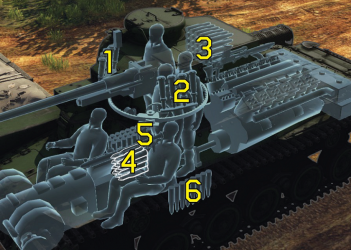
| Full ammo |
1st rack empty |
2nd rack empty |
3rd rack empty |
4th rack empty |
5th rack empty |
6th rack empty |
Visual discrepancy |
|---|---|---|---|---|---|---|---|
| 104 | 75 (+29) | 71 (+33) | 66 (+38) | 54 (+50) | 9 (+95) | 1 (+103) | Yes |
Turret empty: 66 (+38)
Machine guns
Like most Imperial Japanese tanks, the Chi-Ha Kai does not have a coaxial machine gun, and thus must rely on the turret pintle-mounted machine gun. The hull mounted machine gun has very restricted angles of fire and is also mounted fairly low in the hull, thus its utility is fairly limited. The Type 97 machine guns are fed by 20-round box magazines, which along with the small calibre severely limits the effectiveness of the pintle-mounted machine gun against aircraft.| 7.7 mm Type 97 | ||||
|---|---|---|---|---|
| Mount | Capacity (Belt) | Fire rate | Vertical | Horizontal |
| Hull | 3,000 (20) | 499 | -8°/+10° | ±15° |
| Pintle | 1,000 (20) | 499 | ±20° | -10°/+60° |
Usage in battles
The Chi-Ha Kai (Kai means "improved) is an upgrade of the Chi-Ha that replaces the low-velocity 57 mm gun with the very good 47 mm Type 1 tank gun and adds one more crew to make a total of five with three in the turret. Compared to other rank I vehicles this gun is powerful and very good.
The 5th crewman, in a three-man turret, improves survivability accordingly. However it is still a lightly armoured vehicle with only moderate mobility, so the tactics used with the Chi-Ha are to stay close to teammates and always play sneaky remain the most important.
Another problem is that the Chi-Ha Kai retains the hand-cranked turret, which is quite slow to turn. So the best idea is to plan ahead before any attacks, think where the enemy may be and find a place to hide the bulky tank from the enemy and wait for the enemy to come towards the position. Now, this is somewhat important "Don't look for the enemy, let the enemy look for the Chi-Ha Kai.", Of course, the Chi-Ha Kai could still go look for the enemy, but always be on alert and make sure to have a friend for firing support.
The engine provides adequate power - the power-weight ratio is comparable with other tanks of the late 1930's - but this tank was built from 1942 onwards so it is low compared to contemporary designs.
Enemies worth noting:
- B1 bis / ter: the B1 can easily destroy the Chi-Ha when using both of its guns, but when angling only the 47mm gun is available, meaning that the Chi-Ha can take some more hits. It is very hard to destroy the Char B1 from a distance, so get as close as possible with the ideal range being no more than 300m. Aim at their flat hull side, turret side, hull cannon mount or the driving compartment (the near-vertical frontal armor right below the turret). Upon penetrating, the Chi-Ha's 47mm APHE can knock out several crews, and your quick reload allows you to finish the rest off in time. However if the B1 has folded armor plates on their hull sides then it is a B1 ter, avoid shooting at its sides.
Pros and cons
Pros:
- Improved sloped armour compared to the reserve vehicles
- Quite fast (up to 44 km/h), allowing it to get to certain spots in time
- Lovely climbing ability combined with the amazing -15 degrees gun depression, it is great at mountain combat
- Has a vertical stabiliser which most tanks don't have, allowing the Chi-Ha Kai to get the first shot off
- Decent cannon can frontally penetrate common targets like M3 Lee and T-70
- Great turning ability in low gear
Cons:
- 47 mm armament may be underpowered in an uptier, especially in frontal engagements against a B1 bis or Matilda
- Thin armour can be penetrated by 20 mm/.50 cal up close
- Rifle calibre turret-mounted machine gun with small 20-round magazine, severely restricting utility against aircraft.
History
Development
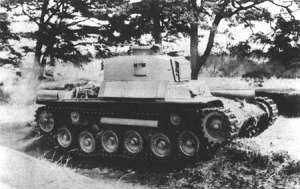
In 1939, the Type 97 Chi-Ha first saw service in the Imperial Japanese Army. It was an improvement over its predecessor the Type 89 I-Go with its improved road speed and armour. However, it still had the same low-velocity 57 mm armament. While adequate against infantry and fortifications, it lacks in anti-tank power to slug it out in a tank-to-tank fight. This came to light when Colonel Seinosuke Sonoda, commander of the 7th Tank Regiment, called for an improvement in the Type 97's armament to the newer 47 mm gun when it was found that the Japanese tanks had trouble fighting even the American M3 light tanks. The request led to the retooling of the factories prepared to produce the 47 mm armed Type 1 Chi-He to instead integrate the turret onto the existing Type 97 chassis. This improved variant of the Type 97 medium tank design was called the Type 97-Kai Shinhoto Chi-Ha (Kai for "Improved" and Shinhoto for "New turret").[1] This new Type 97 would start mass-production in early 1942 next to the original Type 97 model until the 47 mm gun production can keep up with the demand, which did and the Type 97 Chi-Ha Kai became the standard Type 97 model from 1942 to 1943. Up to 930 Type 97 Chi-Ha Kais would be produced in this production lifetime.[2]
Combat Usage
1942-1943
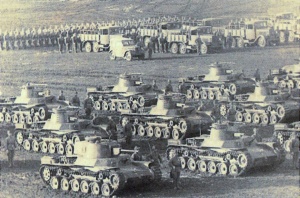
The new Type 97 Chi-Ha Kai first saw use in the Philippines campaign, where the complaint first arose of the inadequacy of the Japanese tank armament. Five were used in the Matsuoka Detachment during the Corregidor landing on 5 May 1942. These tanks helped surmount American defences, which were inadequate in dealing with tank assaults. This eventually led to the Japanese victory in the Philippines on May 6. After these conquests, Japanese doctrinal changes from an offensive standpoint to a defensive one led to a shift in priorities. The defence of Imperial Japan's new territorial gain required a large navy and airforce to provide support in a large distance. The tanks, seen as an offensive type of weapon, were deemed unnecessary in the priorities attached with the industry. Combined with the rejection of any notion of hostility towards the Soviet Union, which would require a large tank force, led to a drop in tank production from priority A1 to a flat D. While tank development continued to progress for improved tanks, this led to the Type 97 Chi-Ha Kai to be the best tank Japan could field out to their garrison stationed in China and the Pacific islands, meaning this was all they had against the incoming American, Commonwealth, and Chinese ground forces.[1]
Regardless, the Type 97 Chi-Ha Kai trucked onwards in the IJA. In the 1942 campaign in the Southwest Pacific, the islands were mainly forested and hilly so it produced an unsuitable environment for tanks. A dozen were used at Guadalcanal as part of the Sumiyoshi Force landing in October as the 1st Independent Tank Company. These tanks helped the Japanese attack the Matanika River, but the Chi-Ha Kais was simply knocked out by 37 mm anti-tank gun the U.S. Marines brought in, leading to an end to armoured operations. The tank force saw more usage in the Central Pacific islands, but in these stages at 1943 and 1944, they faced against superior M4 Sherman fielded by America. With the increasing vulnerability of Japanese tanks to American anti-tank capabilities, commanders often resort to keeping the tanks in entrenched and fixed locations to reduce their exposure and hopefully catch an enemy medium tank by the sides, which the 47 mm can penetrate.[2]
1944-1945
The Type 97 Chi-Ha Kai would see more usage in the Battle of Guam and Saipan when tanks from the 9th Tank Regiment were sent to defend these two vitally important islands. As the Type 97 Chi-Ha Kais were the only tanks able to reasonably defeat the M4 Shermans, it was a substantial upgrade in the Japanese defences in comparison to its previous battles. The Americans invaded Saipan on 15 June 1944 along with two tank battalions consisting of M4A2 Shermans and flamethrower-equipped M3A1 Stuarts. Another weapon to add to the U.S. invasion arsenal was the bazooka, which now presented any U.S. infantry formation with the power to destroy even the heaviest armoured Japanese tank. In the first three days of the Battle of Saipan, the armoured forces were thrown against the American beachhead forces. The first two days had small sporadic units attack the American beachheads, all were annihilated by American bazookas and tank guns. On the night of June 16-17, the entire 9th Tank Regiment's forces of 44 tanks attacked the American lines. Illuminated by navy light flares, all the Japanese tanks in the one of the largest Japanese tank attack of the Pacific war were subsequently destroyed by 37 mm anti-tank guns, M4 Sherman's 75 mm guns, and 60 mm Bazookas. Only a dozen of the tanks committed survived that encounter, but these would only fall victims to the Marine's tanks later in the campaign. These same events happened in Guam, which also had the Chi-Ha Kais of the 9th Tank Regiment, and further showed the technological disparity between the two nations.[2]
Relatively more successful usage of the Japanese tanks was during the Battle for the Philippines that took place from 1944 to 1945. The Japanese employed the 2nd Armoured Division on Luzon while the Americans fielded up to 500 armoured fighting vehicles in 10 different battalions. While outnumbered, a change in battle strategy gave the Japanese armoured forces a fighting chance. The Japanese recognition of the weakness in the Japanese's armour led to many commanders hiding their tanks in dense foliage, waiting for American tanks to come by to nail them in their side armour. Though the battle was still lost, the entrenchment of the tanks in static positions and the strategy of ambushing incoming Allied armour allowed the Japanese tanks to dish out more damage on the Americans than had they charge into the fray like in Saipan. The strangest use of the tanks in this campaign, and perhaps as a show of Japanese desperation, was the use of explosives on five tanks used in a "kamikaze" fashion to ram Sherman tanks before exploding; this strategy took out two Sherman tanks.[1]
By the last years of the war, Japanese armour hopelessly obsolete. Iwo Jima had only a portion of the 26th Tank Regiment with a few Chi-Ha tanks in pillbox formats. Okinawa had 13 Ha-Gos and 14 Chi-Ha Kais facing against 800 Allied tanks. The Burma Campaign that lasted from 1943 to 1945 had the 14th Tank Regiment with Chi-Ha Kais annihilated by British and Indian forces with Shermans and M3 Lees, a show of how obsolete tanks of the European theatre can be superior to even the best Japanese tanks. Perhaps the final blow to Japan's armour was in Manchuria when the Soviet Union invaded in August 1945. The Soviets, whose standard tanks were now the T-34-85 and the IS-2, fielded up to 5,000 armoured vehicles against Japan's 1st and 9th Tank Brigade. The final Japanese tank battle came on August 18, three days after Japan's surrender with the United States, when Soviet forces landed at Shimushu Island. The 11th Tank Regiment, even with the knowledge of their country's surrender, attacked the Soviet forces under the rights of "self-defence if attacked" with 39 Type 97s and 25 Type 95s. The fighting between the Japanese armour and Soviet forces happened until August 20, when a cease-fire is placed.[2]
Post World War II
Even after the war, the Type 97's fight was not over. A large quantity left behind by Japanese forces in China were consequently snatched up and used by both sides in the Chinese Civil War. A few of the Japanese tanks captured by Soviet forces were also supplied to the Chinese and Koreans. The French also used a few captured Japanese tanks in an ad hoc unit known as 'Commando Blindé du Cambodge' in the First Indochina War. [2]
Media
- Skins


See also
- Chi-Ha - (Base hull)
- Chi-He - (Successor)
- Chi-Ha Long Gun - (Navy variant)
- Chi-Ha Short Gun - (Navy variant)
- Ho-Ni I / III - (Gun tank variant(s))
- Ho-Ro - (Howitzer tank variant)
- Other vehicles of similar configuration and role
- Pz.III (Family) - (Early models)
- LT-38 (Family)
- M15/42
- Lago I
External links
References
| Japan medium tanks | |
|---|---|
| Type 97 | Chi-Ha · Chi-Ha Kai · Chi-Ha Kai TD · Chi-Ha Short Gun |
| Type 1 | Chi-He · Chi-He (5th Regiment) · Ho-I |
| Type 3 | Chi-Nu · Chi-Nu II |
| Type 4 | Chi-To · Chi-To Late |
| Type 5 | Chi-Ri II |
| Type 61 MBT | ST-A1* · ST-A2* · ST-A3* · Type 61 |
| Type 74 MBT | ST-B2* · Type 74 (C) · Type 74 (E) · Type 74 (F) · Type 74 (G) |
| Type 90 MBT | Type 90 · Type 90 (B) · Type 90 (B) "Fuji" |
| Type 10 MBT | TKX (P)* · TKX* · Type 10 |
| Other | Ka-Chi |
| USA | ▅M4A3 (76) W · ▅M47 |
| *Prototype | |



